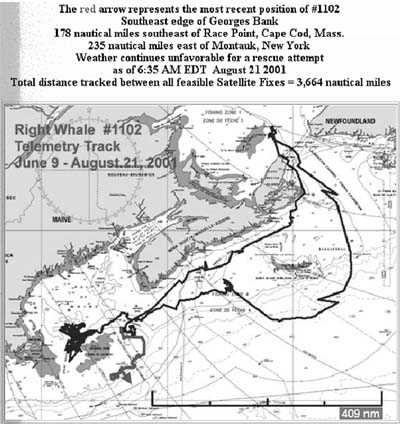
![]()
Volume 5, No. 3
Promoting Cooperation to Maintain and Enhance
Environmental Quality in the Gulf of Maine
|
||||||||||
|
Regular columns |
|
Current stories |
|
Archives |
|
About |
By Kate Hanson
A baby boom of 30 right whale calves caused great rejoicing earlier this year. The average calving rate for this severely endangered species is 11 to 12 calves a year. Last year surveys only spotted one new calf.
With the total right whale population hovering at the 300 mark, it is important that each and every calf survives. Unfortunately they face numerous threats. Four of this year's calves have already perished-two from unknown causes and two from ship collisions, a common cause of right whale mortality. In the past few years, ship collisions have been responsible for eight of the 21 known right whale deaths. The slow moving cetaceans migrate through a busy shipping corridor and seem to be unaware of the traffic around them, making it a challenge to protect them.
In Canada, the Department of Fisheries and Oceans (DFO) has stepped up its educational efforts and alerted mariners from yacht club owners to the Canadian Navy to avoid right whale areas whenever possible. If the areas cannot be avoided, DFO asks mariners to slow down and post extra lookouts. Jerry Conway, DFO's species at risk coordinator, says the shipping industry is cooperating by voluntarily reporting right whale activities. Bulk carriers, cruise ships, fishing boats and tour operators are complying with requests to avoid whale areas and calling in their own sightings, he says.
Researchers at Dalhousie University are also investigating the possibility of tracking the right whale by sound, making it possible to track the whales in fog, at night and during bad weather. However, it will be three to five years before the system could be in full-scale use. Similar research is being conducted in the United States.
Fishing gear also presents a threat to whales. This was highlighted this summer when the Whale Disentanglement Network, a partnership of U.S. and Canadian government and private organizations, struggled to save Right Whale 1102, also known as Churchill. The distressed whale was first spotted off Cape Cod in early June with deep lacerations caused by imbedded fishing gear, which was tightly wrapped around its jaw. Rescuers attached a satellite/VHF tag so they could track his progress as they made several heroic attempts to disentangle him.

The Center for Coastal Studies has tracked Right Whale
#1102, Churchill, since the early June and has posted a map of the whale’s
route on its Web site. Courtesy of the Center for Coastal Studies.
By mid-July, when Churchill had moved into Canadian waters off the coast of Halifax, the lacerations were badly infected. His skin was flaking off and his condition was deteriorating rapidly. The network had planned another rescue attempt with the cooperation of the Canadian government, but things were put on hold after Churchill started moving into the deeper water at a speed of 4 knots.
As of press time in mid-August, Churchill had passed through the Cabot Straits and was travelling along the eastern shore of Cape Breton Island. On August 15, he was tracked off the northeastern peak of Georges Bank, 106 nautical miles from Yarmouth, Nova Scotia. High winds and fog had prevented further entanglement efforts. Dr. Stormy Mayo, a senior scientist at the Center of Coastal Studies (CCS), said in a telephone interview from Cape Cod, that the whale was still wearing his satellite tag, which will help researchers understand more about where the small group of right whales that do not congregate in the Bay of Fundy go because not much is known about them. (For a complete update on Churchill and other whale disentanglement efforts visit CCS's Web site at www.coastalstudies.org/rescue/1102.htm).
To prevent the whales from becoming entangled, fishermen along the east coast are asked to use specialized breakaway nets and lobster pot lines. Though the action of the high tides makes nets impractical in the Bay of Fundy, the Maritime Fishermen's Union is conducting load tests on fishing gear to see if it would be possible to replace some lines with breakaway lines.
Whale watching has raised people's awareness of the plight of the right whale, but it can also affect whale behavior. In Canada, most of the tour boat operators have signed the voluntary Whale Watching Code of Ethics, which is designed to minimize disturbance to the whales, so they are not harmed by the popular tourist activity. In the U.S., federal regulations prohibit boats from coming within 500 yards of right whales. Mayo is quick to commend two tour boat operators who spotted a right whale last year and stood by it until the disentanglement team arrived. Through their efforts one more member of this highly endangered species was saved.
Scientists believe that changes in atmospheric conditions in recent years has led to a high abundance of the whales' favorite prey-the copepod Calanus finmarchicus. As the whales feast on the copepods, their condition improves and their chances of a successful pregnancy increases. The copepods have been widely available in right whale feeding grounds such as the Cape Cod basin, which could mean another record calving season this winter.